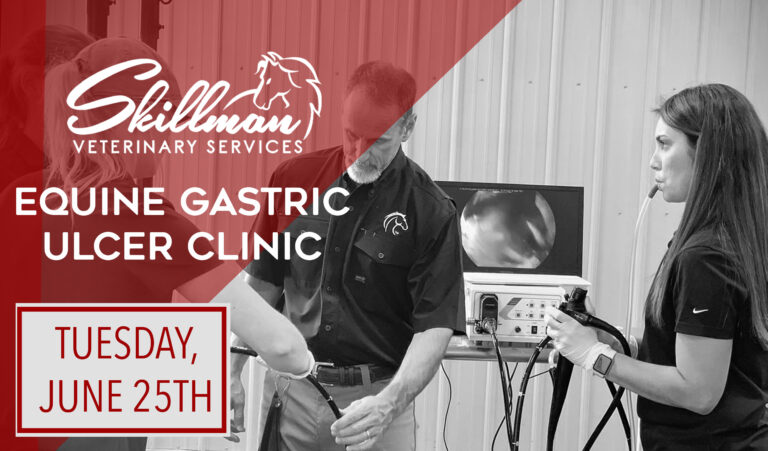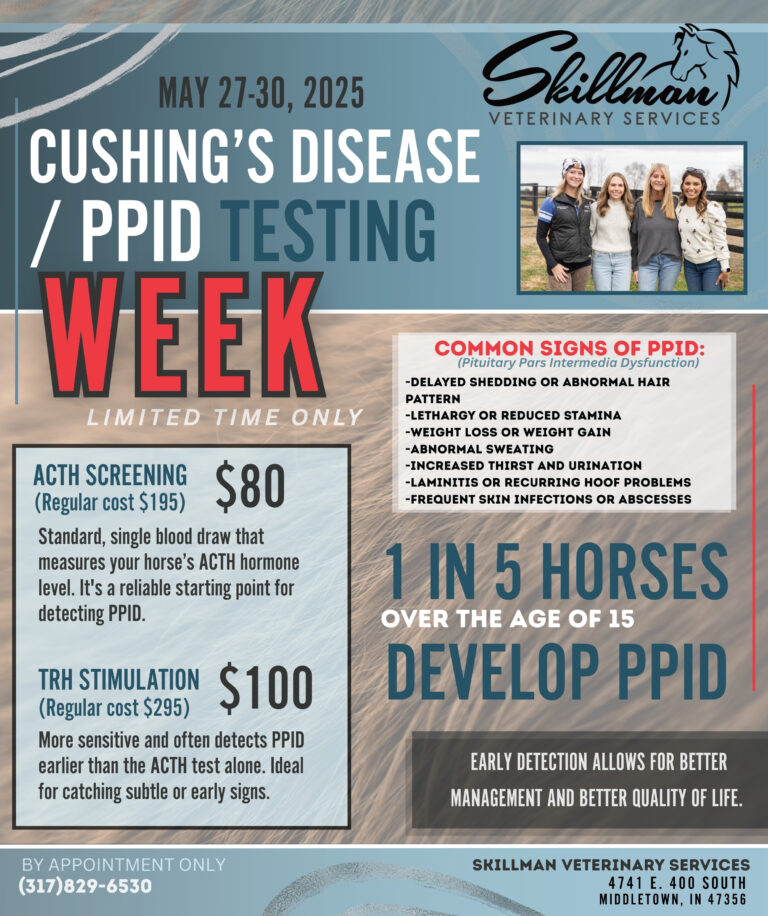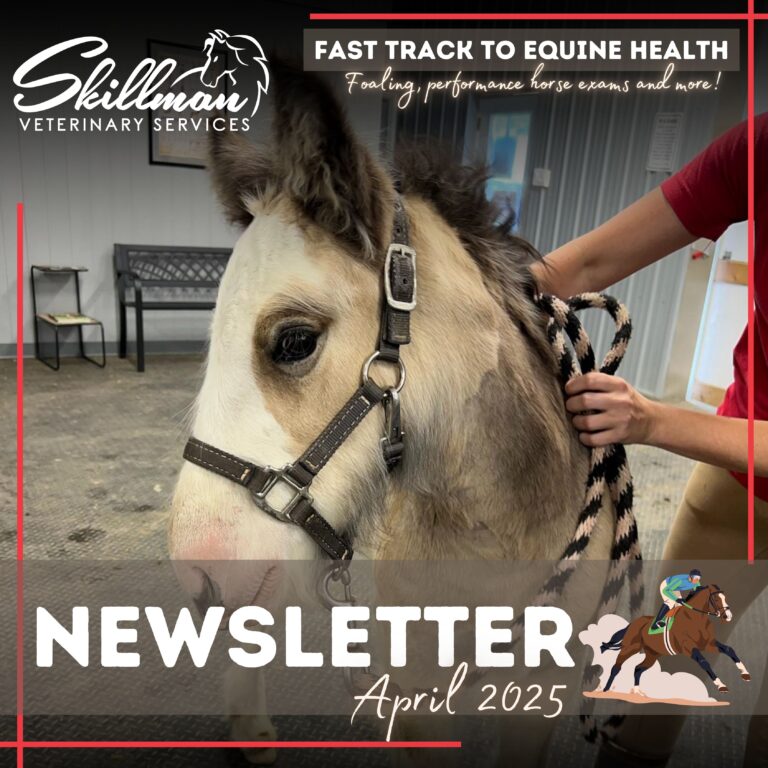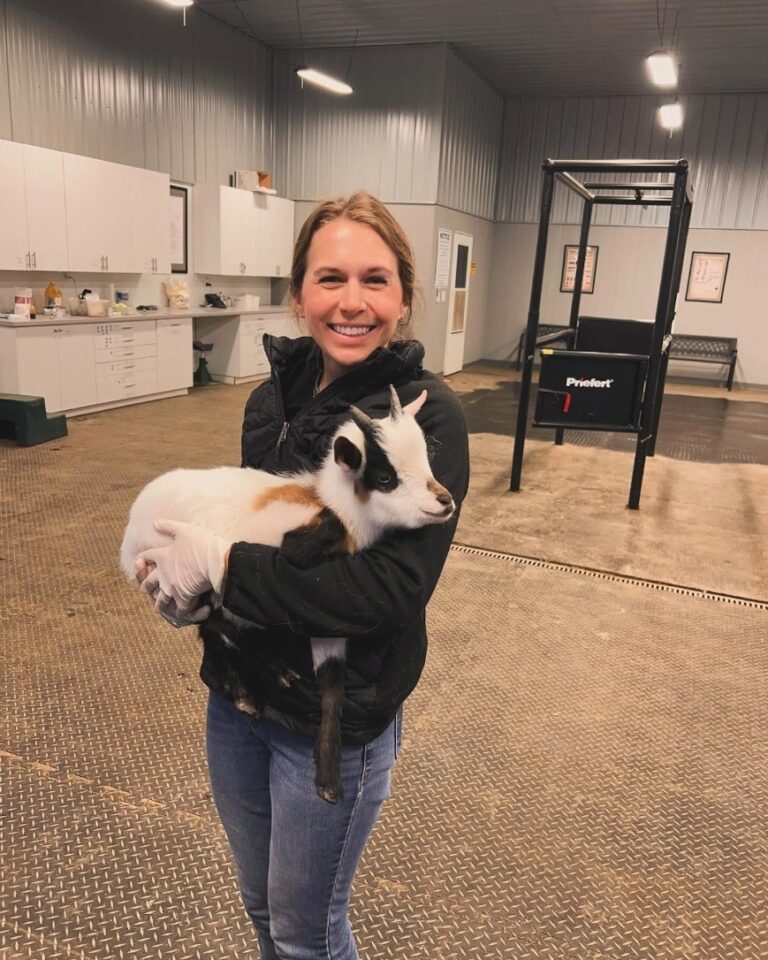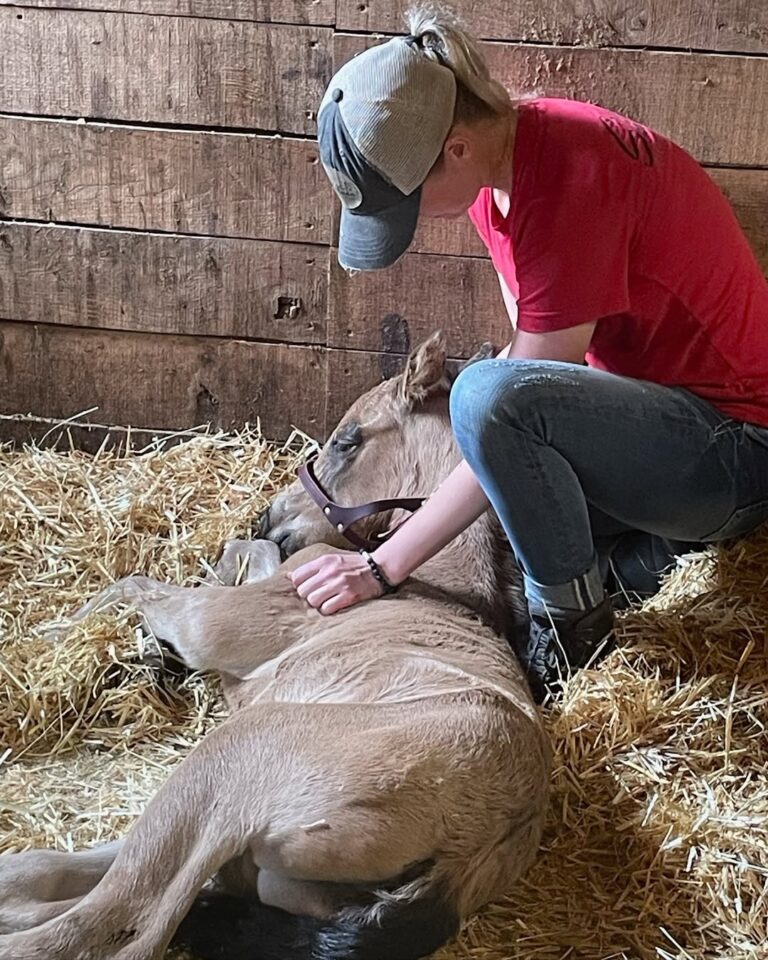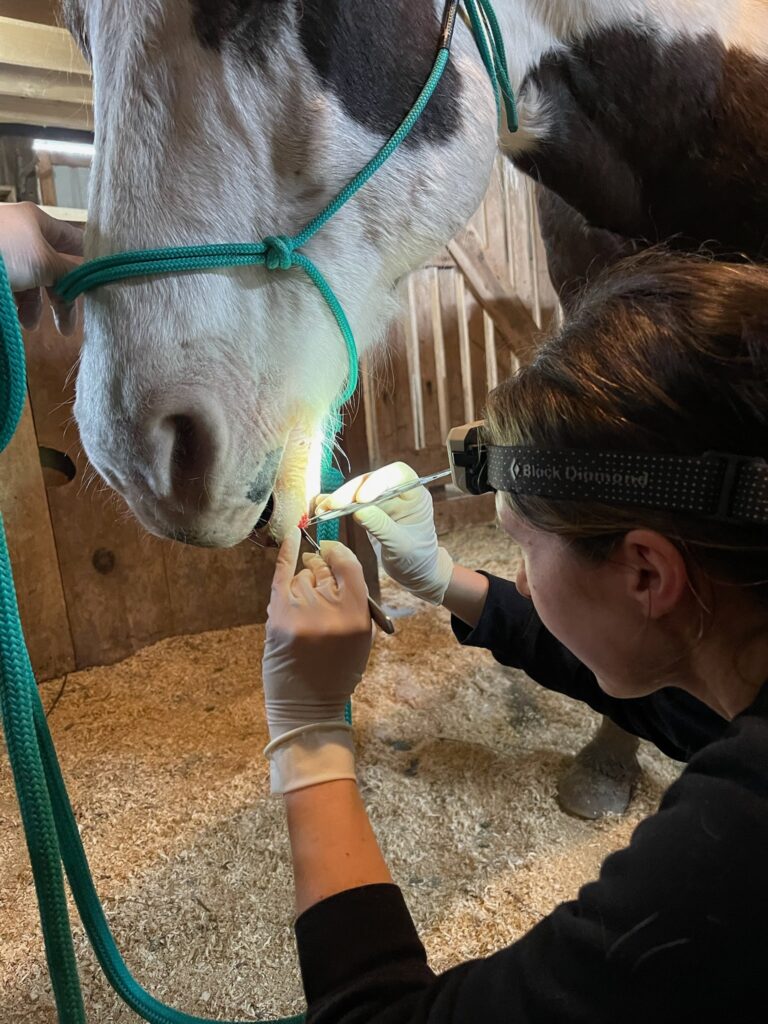Deworming Horses and Fecal Tests
Parasitic worms live in the intestines of horses and ponies. Small numbers of worms can be tolerated, causing no effect on well-being. Larger worm burdens can cause a range of problems including ill thrift, diarrhea, colic and death. Pasture management and drug administration assist the horse’s immune system in keeping the intestinal population of worms under control. The immune response to worms is better in some horses and ponies than others and as such some are more susceptible to worm infestation.
What types of worms are there and what problems do they cause?
1. Small redworms (Cyathostomes): as the horse grazes it swallows the larvae of the small redworms, that can be found on blades of grass in contaminated pastures. The larvae colonize the lining of the large intestine where they develop into adults who lay eggs that are passed with the horse’s droppings onto the pasture and develop into larvae to complete the lifecycle. Larvae picked up in the autumn can go into hibernation in the intestine wall. These ‘encysted larvae’ can survive in this state for a considerable length of time, to develop into adult worms when the conditions become right for them, typically in the spring. It is the emergence from the bowel wall of large numbers of encysted larvae that can result in severe diarrhea. Other symptoms of cyathostomiasis include weight loss, lethargy and mild intermittent colic.

2. Large redworms (Strongyles) (such as Strongylus vulgaris, S. edentatus and S. equinus): again, larvae are picked up and swallowed as the horse eats contaminated pasture. The lifecycle of these worms involves the migration of larvae through the blood vessels of the intestine and liver, where they can cause inflammation and obstruction of the blood vessels resulting in damage to the intestine supplied by the damaged vessel. Symptoms of infestation can include colic, ill thrift, and diarrhea.

3. Ascarids (such asParascaris equorum): these worms typically affect younger horses, particularly foals as a good immune response develops with age. Worm eggs are picked up and swallowed while grazing. The eggs develop into larvae that migrate through other organs such as the liver and lung before returning to the small intestine to develop into adults, when they can again complete their lifecycle by shedding eggs.
Heavy infestation can cause stunted growth, ill thrift, lung damage, diarrhea and colic due to intestinal obstruction.

4. Strongyloides westeri: this parasite usually affects the small intestine of young foals and is transmitted from the mare to the foal as larvae in the milk. Typically a strong immune response is developed keeping the infection under control as the foal ages, but where large doses of larvae are swallowed and foals are overcrowded or immunocompromised, severe diarrhea can occur.
5. Tapeworms (Anoplocephala perfoliata): these typically live at the junction between the small intestine and cecum. A mite, present on the pasture, acts as the intermediate host for the transmission of tapeworms, allowing it to complete its lifecycle. Recently it has become apparent that tapeworms are important causes of spasmodic colic in horses. Also, it causes intussussception (telescoping of a piece of large colon or cecum inside itself) that causes severe colic that requires urgent surgical correction. Other symptoms include weight loss and diarrhea.

6. Bots (Gasterophilus spp.): these are the larvae of the adult bot fly. The larvae develop in the stomach of horses and are passed in the droppings. They hatch and the adult flies lay eggs on the horses’ coat, usually on the legs. The eggs are then swallowed when the horse licks its legs. Bots can result in mild ulceration of the stomach wall and have been reported to have caused stomach ruptures but are now rarely recognized to cause a problem.

7. Lungworm (Dictyocaulus arnfieldi): the larvae of this worm can be found in the lungs of horses that live with donkeys and can cause parasitic bronchitis and bronchopneumonia.

How are worm infestations diagnosed?
Typical signs and symptoms (including ill-thrift, weight loss, colic, diarrhea) and poor quality management (overcrowding, inadequate and contaminated grazing, and inadequate use of effective wormers) often suggest that intestinal parasitic problems are most likely. Laboratory investigations are the definitive method of diagnosis. Two types of tests are performed:-
1. Dropping samples are analyzed to count the number of worm eggs per gram of feces. This gives an indication of the types and number of adult worms present in the intestine who are producing eggs. False negative results can occur when the adult worms are not producing enough eggs to be detected and this can sometimes occur when the horse is very unwell. Dropping samples are most useful when collected from all or representative batches of horses on a routine and regular basis to monitor the success of a worm control program.
2. Blood samples are used to evaluate the severity of the worm larval activity in individual horses. This is done by measuring total and differential white cell counts and specific protein levels. Recently, a blood test has been developed to demonstrate tapeworm infestations.
How can I make sure my horses do not suffer from parasitic worms?
Whether you own one horse or a whole stud farm, you should develop a worm control policy with advice from your veterinarian. This will be based upon many factors including your geographical location, the types and ages of horses that you have, your stocking density and the frequency with which horses come and go at your premises. Effective parasite control depends upon both management of grazing to minimize worm egg and larval contamination and the use of wormers to remove parasites from the horses’ intestines. One cannot be adequately effective without the other.

How can I best manage my available grazing?
Horses re-infest themselves by eating parasitic eggs or larvae by grazing contaminated pasture. Therefore:-
1. All horses grazing the pasture should be well wormed to reduce their output of parasitic eggs and larvae.
2. New arrivals should be treated with an effective wormer on arrival and should be stabled separately for 2-3 days before turning out on clean pasture.
3. The pasture should not be overcrowded so horses can avoid eating contaminated grass.
4. Droppings should be frequently and regularly picked up and removed from the pasture to minimize contamination. If you have sufficient acreage, mechanical ‘dropping pickers’ (vacuum-type devices powered by small tractors), are particularly effective.
5. Ideally paddocks should be regularly grazed with other species such as cattle or sheep, in rotation and then rested. These animals are not affected by equine parasites, their parasites do not affect horses, they graze more evenly than horses and their droppings stimulate good grass growth.
How can I best use worm medicines?
Anthelmintics (dewormers) are medicines that are given to the horse by mouth to kill intestinal parasites. When used correctly and efficiently, many are very effective, but some populations of worms have developed resistance to the effects of some of the drugs, over the last decade, and they need to be used strategically, according to age of horse and time of year. Strategic deworming also minimizes the chances of stimulating the development of resistance.

For the single horse owner and owners of small stables, an approach is to collect fecal samples and blood samples periodically and then to select anthelmintics depending on the population of worms present, i.e., ‘target deworming’. Fecal and blood samples can be used after deworming to see if the drug used has been effective.
For commercial stud farms and intensively managed livery and training stables, a more structured approach is required. Foals who are born and raised on commercial stud farms should be first wormed at 4 weeks of age to avoid Strongyloides diarrhea, and then dewormed 4-6 weekly thereafter. The frequency with which deworming is required depends upon stocking density, pasture contamination and equine ‘traffic’.
If you own one or a few horses and they have access to large clean paddocks, they will require to be medicated less frequently than if you run busy commercial stables or a stud farm where horses are regularly coming and going from other, often uncertain, managements.
There are now two main classes of equine anthelmintics that are useful as routine wormers against a broad spectrum of parasites. These are the ivermectins (e.g., Eqvalan, Quest) and the pyrantel drugs (e.g., Strongid-P). There are several formulations made by different manufacturers and your veterinarian will make recommendations. Some formulations are claimed to need less frequent dosing but this should always be checked by periodic fecal sample tests as local management factors may result in varying efficacy. It is recommended that one class of drugs is used routinely for one year and then the other is used during the next year, to help discourage resistance developing in the worm population. Then, during spring and autumn, to strategically avoid problems with small Strongyle worms (cyathostomes), horses should receive a specific five day course of fenbendazole (e.g., Panacur) and then a double dose of pyrantel to avoid problems with tapeworms. A dose of ivermectins during December will strategically remove stomach Bots.
For horses kept under intensive management conditions, strategic monthly worming may be necessary, in addition to good management of grazing.
Can pasture management alone reduce the incidence of worm problems?
Pasture hygiene is of paramount importance in controlling worm burdens. Droppings should be regularly removed from the paddock, ideally daily and certainly at least once or twice a week. Paddocks should never be overgrazed, reducing the need for horses to graze close to droppings. Paddocks should be rotated and rested. Good management alone may successfully control parasites for a static horse population, but this must be regularly checked by dropping sample analysis and new arrivals should always be dewormed before being turned out.
What is the best approach in Boarding Stables?
These facilities can be a problem if individual owners are responsible for their own horses’ worm control. Ideally all horses and ponies should follow the same program either target or interval dosing to prevent those being treated from being re-infected by those not being treated. Similar problems can occur with vaccinations. Best policy, for the health and welfare of the population, is to include routine deworming and vaccinations in the costs of boarding and for all horses to be dosed at the same time in accordance with stable policy.
How should horses be treated if there is a ‘breakdown’ in my worm control policy?
This may occur if management or worming failures occur or if an individual horse’s immunity becomes compromised by, for instance, another illness. Typical signs and symptoms may develop (e.g., ill-thrift, weight loss, colic, diarrhea). Horses with colic associated with damage to intestinal blood vessels or twists or telescoping (intusussception) of sections of bowel may require emergency abdominal surgery to try to save their lives. Horses with severe diarrhea and toxemia may require hospitalization and intensive care. In terms of specific anthelmintic treatment for ‘out of control’ small Strongyle (cyathostome) infestations, clinical experience suggests that 5 daily double doses of fenbendazole is most reliably helpful and for tapeworms, double doses of pyrantel drugs are required
In spite of our modern scientific knowledge and the availability of efficient worm medicines, intestinal parasites remain the most important cause of disease in horses and ponies world-wide. The most important reasons are overcrowding on poor quality and highly contaminated grazing, failure to keep grazing areas clean of droppings and the inadequate use of effective wormers. Buying dewormers from traveling salesmen on the basis of cheap offers, without specific advice from your own veterinarian, who knows the needs of your horses, is often a recipe for the breakdown of your worm control program. Formulate a specific program with your veterinarian.
Contributors: Deidre M. Carson, BVSc, MRCVS & Sidney W. Ricketts, LVO, BSc, BVSc, DESM, DipECEIM, FRCPath, FRCVS.
Edited by Kim McGurrin BSc DVM DVSc Diplomate ACVIM
© Copyright 2010 Lifelearn Inc. Used and/or modified with permission under license.

